|
1943, in the midst of World
War II, was about the beginning of the time when all the fantastic predictions
of flying cars, video phones, domestic robots, two-day work weeks, meals in pill
form, self-driving lawn mowers, self-driving cars, moon and planet habitats, and
other creations were being pitched by technical magazines like Popular Mechanics,
Popular Science, Science and Mechanics, Mechanix Illustrated, and others. Even the
"women's" mags were full of promises of automated everything to make housework simpler.
While many of the fundamental inventions has since been created, only a few have
evolved to full maturity as envisioned. A flying machine in every garage is one
which has not. Such a Jetsons-like environment has never been a practical option
because of the complexities and inherent danger of managing traffic in three dimensions,
and with unskilled operators. Self-driving cars in two dimensions has been tough
enough, and still is in its infancy. We are grateful, though, for the people who
have been working hard to finally bring such dreams to reality.
Set'er Down in Your Back Yard
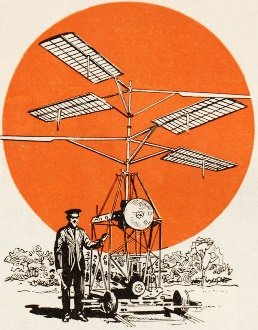
Igor Sikorsky beside one of his first helicopters at Kiev, 1908.
It was a beginning, but it wouldn't fly.
By Roderick M. Grant
This is no midsummer day's dream. Your next car may be a helicopter.
Pure poppycock, you'll say; the thing is fantastic. For 30 years, if you're that
old, you have read tales of that crazy contraption that would hoist itself by its
own bootstraps six feet off the ground and then come down to the good earth with
a bone-breaking thump. Then you'd drive twelve miles to the airport and watch those
$100,000 sky liners climb away gracefully at 125 miles an hour, and if you thought
of the helicopter again you wondered why crackpots went on wasting time with these
impractical dancing dervishes when the sky was filling with Clippers and Stratoliners
and Flying Fortresses.
You have been misled. Alone, since 1908, one man has been laboring to build a
craft that you can lift safely from between the cherry trees and the Monday wash
line in your urban back yard and set down as gently as a toy balloon between two
parked cars.
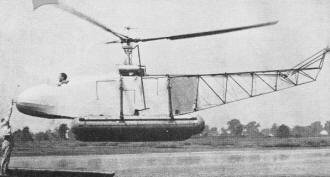
Fitted with pontoons for landing on water or land, the Sikorsky
VS-300 helicopter hovers motionless in air before alighting.

Demonstrating perfect control, the pilot pierces a paper target
and gently lifts away a metal loop set in top of a pole.
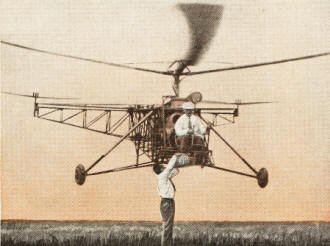
In this panel are the three stages of the experimental helicopter,
first of its breed to fly successfully. The original model, above, had outrigger
structures extending from the tail, with twin rotors.

The outriggers were dropped in the first major revision and a
tower over the tail substituted, carrying a single rotor.
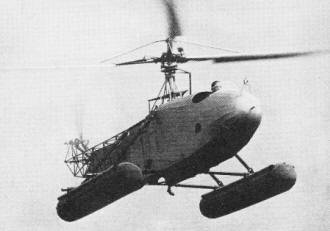
In the present version the tower has been scrapped, pontoons
replace wheels.
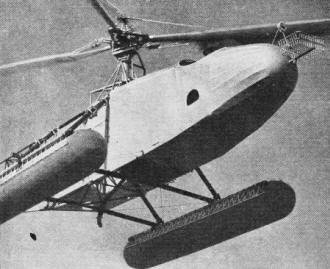
Ingenious controls in main rotor mast permit sidewise, backward,
forward or vertical maneuvers.

Its arms thrashing just enough to counteract gravity, the helicopter
waits upstairs while its "ground crew" attaches a can of gasoline to line to refuel.

Photo-diagram shows the principal elements of control. After
the war, you may learn to fly it in an afternoon.
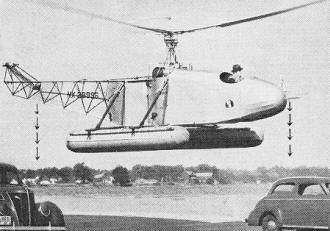
Mr. Sikorsky sets the VS-300 down between parked cars, in a space
just wide enough to allow clearance of the fourteen-foot main rotor blades.
And lo, the helicopter has arrived. You believe when you see it rise vertically
to hover like the frozen motion of a hummingbird, swim backward in air as easily
as forward, do a right-about-face with a doughboy's precision and swing from side
to side as smoothly as a pendulum.
The thing still looks like the skeleton from an inventor's closet and you subconsciously
search the sky for the invisible string from which it must be hanging. But it has
arrived at its beginning, and the principal obstacles between the helicopter and
your garage are lack of a nickname - helicopter is still a 25-cent word with controversial
pronunciation - and lack of a production line.
The nickname is up to you. The production line is up to Igor Sikorsky, the unassuming
genius who nursed the unbelievable craft for 31 years before he got it to work,
and had time meanwhile to turn out some of the world's largest commercial transoceanic
flying boats.
Mr. Sikorsky is a native Russian and today is a more passionate American than
you or I. He built his first edition of the helicopter at Kiev in 1908. It looked
like a Dutch windmill upended, and it wouldn't fly. That did not discourage Mr.
Sikorsky. He built a second helicopter that also didn't fly. Then he began building
fixed-wing craft, mostly multi-engine planes, until the tragedies of the bolshevik
revolution drove him from his homeland. He translated his endeavors to America,
building land planes and amphibions and flying boats. It was a long time before
he tackled the wingless machine again, and a flying generation had grown up before
the Sikorsky helicopter first thrashed its great arms and rose into space.
That was 1939. In the four years since, 18 major changes have been made in the
craft and more are in the making. The original helicopter of 1939 is the same steel
dragonfly that darts over the bay at Stratford, Conn., today in absurd aerial evolutions.
It is like the Model T Ford that entered its second 100,000 miles with none of its
original parts.
Up to this moment Mr. Sikorsky has confined himself to a search for stability,
control and smoothness of transmission and rotor operations. Those fundamentals
having been solved, save for the refinements time and experience will bring, the
inventor will be free after the war to attack the problems of production. They will
be simple. Basically the helicopter is a framework of welded steel tubing with a
main rotor and a tail rotor driven by a gasoline engine and operated by an ingenious
set of controls; it should cost no more than a medium-priced automobile, and it
presents much less difficulty than the automobile in mass production. Since the
war's end will undoubtedly see a vastly expanded aviation plant seeking peacetime
employment, the helicopter should find a home. There will remain the problems of
stepping up performance beyond the present easy pace of 80 miles an hour, increasing
the capacity of the experimental VS-300 to family size, and convincing you the helicopter
is no neck-breaking aerial jungle gym for daredevils but the safest and most convenient
aircraft invented for a cliff-dwelling kitchenette civilization.
So far as the neck-breaking proclivities of this flying machine go, it is significant
that Mr. Sikorsky still has his own neck. True, in his pioneer experiments he took
the precaution to fly his helicopter as a captive, maneuvering it over the factory
yard while assistants restrained it within a safe distance of earth by rope. Now
that the controls are perfected the VS-300 hops around as unfettered as a mosquito,
which it resembles except for the sting.
"The helicopter can do what no eagle can," says Mr. Sikorsky. "Indeed, it can
perform as no other thing on earth - fish, flesh, fowl or mechanical. No eagle can
hover. No bird can fly backward. No ship can swim sideways. No plane can rise vertically
from a standing start. But, to be quite humble about it, the helicopter can't do
much that a mosquito can't do."
At the Sikorsky plant you may meet the only two Americans licensed to fly the
only helicopter in the hemisphere. Igor Sikorsky holds No.1 private license. Charles
L. Morris, test pilot, holds No.1 commercial license. It is the opinion of these
two that you could learn to fly the helicopter in two hours. You will learn more
safely than the airplane pilot, for you need not roar across a field at 60 miles
an hour to take off or alight. When the helicopter has its day, you can learn by
maneuvering the craft through its three-dimensional repertoire while it hangs from
its gyrating umbrella, anchored a few feet above the ground by ropes. If your engine
fails, you drift to the ground under the restraining influence of the free-wheeling
main rotor blades.
When Mr. Sikorsky established a world's endurance record of 1 hour, 32 minutes
and 26.1 seconds in the air on May 6, 1941, the VS-300 was an ungainly skeleton
with four fans: a three-bladed main rotor mounted on its complex control tower aft
of the pilot, who sat on the nose in quite as exposed a position as the Wright Brothers
in their kite of 1905; two smaller horizontal rotors on opposite ends of outrigger
structures jutting sidewise from the tail, and a vertical tail rotor with sidewise
thrust for turning and torque compensation. The outrigger blades turned in opposite
directions and provided lateral (sideways) and longitudinal (fore-and-aft) control.
In the next major stage the outrigger bridgework was shorn off and a tower installed
over the tail with a single rotor. This was still crude and clumsy, and on the theory
that the simplest structure works best the tower was scrapped after extensive and
satisfactory experimentation. The VS-300 had reached substantially its present form.
The cockpit was later covered with fabric, and a vertical fabric fin from midsection
to tail improved stability. Surviving the innumerable changes are the main rotor
consisting of three 14-foot blades turning 260 revolutions per minute in hovering
flight, and a single 7-foot 8-inch tail propeller rotating in a vertical plane.
The blades of the tail rotor, controlled by rudder pedals, vary from positive to
negative in thrust for directional control, and with the pedals neutral there is
a slight positive angle in the blades to compensate for the torque of the main lifting
rotor. By pressing on either pedal the pilot can turn the helicopter right-about-face
in its own length.
In the cyclic pitch control which is the brain of the main rotor lies the greatest
investment of genius. Within the last year this has been perfected to the point
that the rotor blades, at the command of the conventional stick, change their angle
of incidence progressively as they revolve. With the stick forward, for example,
each blade increases its pitch as it swings to the rear, is feathered at the sides
and is at lowest pitch when it swings in front; the result is to tilt the craft's
nose slightly downward for forward flight. With the stick back, the cycle of pitch
is reversed and the helicopter goes into retreat. The helicopter engineer, instead
of speaking of the wing angle of attack, refers to the inclination of the disc described
by the rotor. Tilt the disc to the right and the craft moves in that direction.
Similarly, the weight carried is described as disc loading rather than wing loading;
that of the VS-300 is 2.25 pounds per square foot of disc.
The stick, operating the cyclic pitch control, determines the direction of flight.
At the pilot's left hand is a second control lever which increases or decreases
the thrust of the main rotor blades simultaneously to control the rate of ascent
or descent. The throttle is synchronized with this to provide automatic change of
power as the angle of the blades changes, so that revolutions per minute remain
constant. These two levers and the rudders are the controls, simple in operation
as they are ingenious and complex in conception.
Recently Mr. Sikorsky has been trying a two-blade main rotor, which would simplify
storage. The helicopter still flies with one less blade, but there is more vibration.
The difference is that between a 4-cylinder and a 2-cylinder car. It may work yet.
The VS-300 with its pilot weighs 1,300 pounds. Mr. Sikorsky sees no reason why a
helicopter of 10 tons gross weight, carrying 20 passengers and cargo, cannot be
built. The VS-300 flies 70 to 80 miles an hour, 8 miles to the gallon with its 90-horsepower
Franklin engine. They can improve those figures when they try.
Before this war is over the helicopter may be in it. It takes little imagination
to see the helicopter as an ideal liaison craft, landing in a forest clearing or
on a headquarters roof; or as an observation post hovering high above the ocean
or battleground; or as an aerial machine-gun nest in lieu of barrage balloons. Rising
vertically above a fort or factory it could meet enemy bombers halfway with a hail
of bullets. The army tried an autogiro in mock battle against fighter planes and
dive bombers some years ago, using cameras for guns. The autogiro got more photographic
hits in its gun sights than either of its combatants. The dive bomber can't aim
or evade; the pursuit plane is less accurate than the slower autogiro. The helicopter,
which can sit still or dodge and keep firing, should out-perform the autogiro, which
must keep flying forward for buoyancy.
After the war the helicopter surely will be the aerial runabout, climbing out
of the back yard to fly to the grocery or the downtown office or the airport, settling
gently into any space large enough to contain its structure. It is not designed
for high-speed commercial air travel nor heavy cargo, but it should solve the problem
of ferrying passengers from outlying airports into crowded cities.
Fitted with rubber pontoons, the VS-300 is at home, like the Marines, on land
- on the sea - and in the air. It lands on your concrete driveway so tenderly the
pilot might hold a cup of coffee without spilling. It alights on a back yard pond
with scarcely a ripple. In the Sikorsky yard they nose it up to a post and lift
a ring off its top, hang it three feet above ground while someone loads a suitcase
into a luggage rack on the nose, or poise upstairs while an assistant hooks a can
of gasoline on a rope to be hauled up.
The airplane, says Mr. Sikorsky - and he builds them - in spite of its excellent
speed and carrying efficiency, is a very helpless machine with respect to points
of takeoff and arrival. The helicopter is the most independent creature man has
devised.
Posted
|



